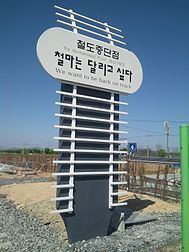Native name 경원선 (京元線) Line length 94.4 km (58.7 mi) Stations 37 | Status Operarional | |
 | ||
Opened Stages between 1911–1914 Number of tracks Double track (Yongsan–Dongducheon)Single track Owner Korea Rail Network Authority Terminis Baengmagoji Station, Yongsan Station Locale | ||
The Gyeongwon Line is a railway line serving northeastern Gyeonggi Province in South Korea. The line is operated by Korail. The name of the line came from Gyeongseong (Seoul) and Wonsan, the original terminus of the line in what is now North Korea.
Contents
History
The Gyeongwon line was opened along its full length between Yongsan Station in Seoul and Wonsan by the Chosen Government Railway on August 16, 1914. This line was extended as follows:
The Gyeongwon Line was the first in Korea to be electrified, as part of a plan to create an electrified line all the way from Busan to Xinjing, Manchukuo. The first stage of this plan was the electrification of the Gyeongwon, Gyeonggyeong and Gyeongin lines, and in March 1940, the Imperial Diet budgeted 3.6 million Yen for electrification equipment for this plan, Electrification of the Pokkye-Kosan section of the Gyeongwon line began in December 1940; it was completed and commissioned on 27 March 1944, and commercial electric operations commenced on 1 April 1944.
The division of Korea cut the line in half in 1945. The South Korean part of the line is 88.8 km (55.2 mi) long between Yongsan and Sintan-ri. The North Korean section is now part of the Kangwŏn Line.
Following the 1961 coup, the Supreme Council for National Reconstruction started South Korea's first five-year plan, which included a construction program to complete the railway network, to foster economic growth. As part of the program, in the outskirts of Seoul, a 4.9 km (3.0 mi) long avoiding line was built from Kwangwoon University to Mangu on the Jungang Line, called the Mangu Line, which opened on December 30, 1963.
Upgrade
The section of the Gyeongwon Line in the Seoul metropolitan area was among the first to be electrified with the 25 kV/60 Hz AC catenary system in South Korea when it was integrated into Seoul Subway Line 1. Further sections were electrified and Line 1 services was extended in the 1980s and then in the 2000s:
Altogether 55.6 km (34.5 mi) of the line was electrified, and 53.1 km (33.0 mi) was double-tracked.
On September 1, 2010, the South Korean government announced a strategic plan to reduce travel times from Seoul to 95% of the country to under 2 hours by 2020. As part of the plan, the Gyeongwon Line is to be further upgraded until Uijeongbu for 230 km/h and may see KTX service.
In 2012 restoration of the line was completed between Sintan-ri Station and Cheorwon Station.
Major stations
North Korean section
The North Korean section, between P'yŏnggang and Wonsan has been extended northwards to Kowon and now forms the Kangwon Line.
